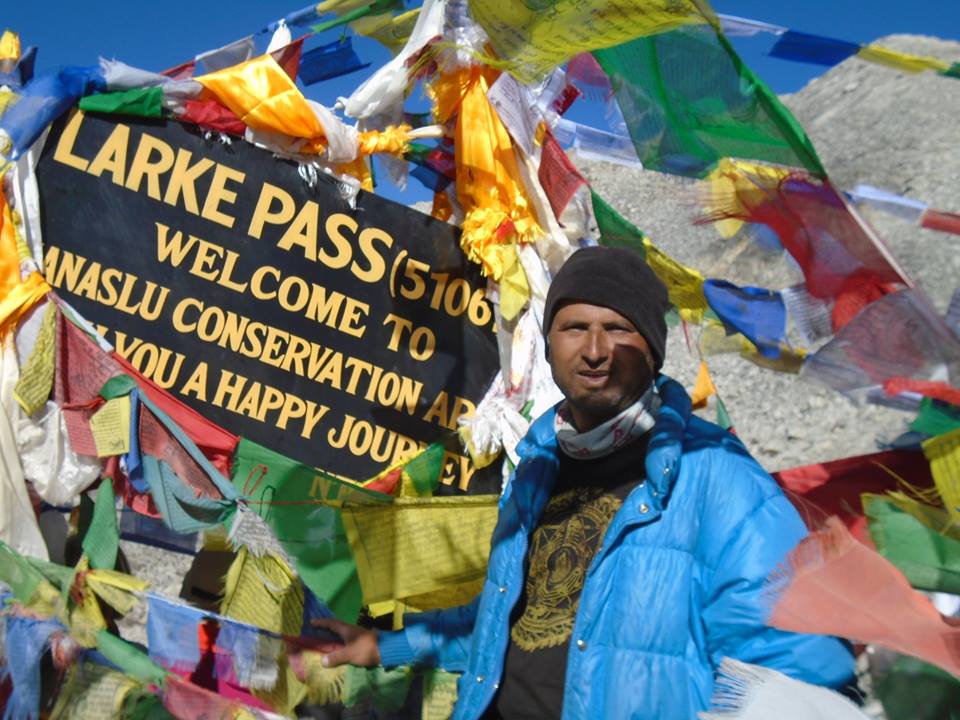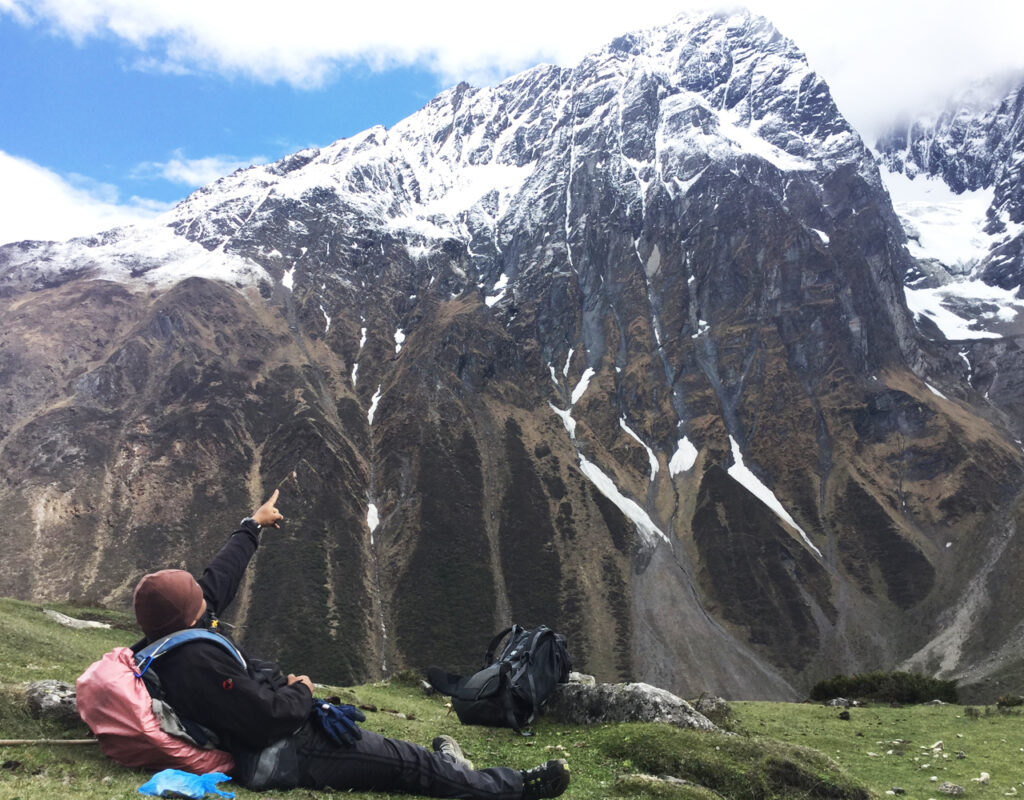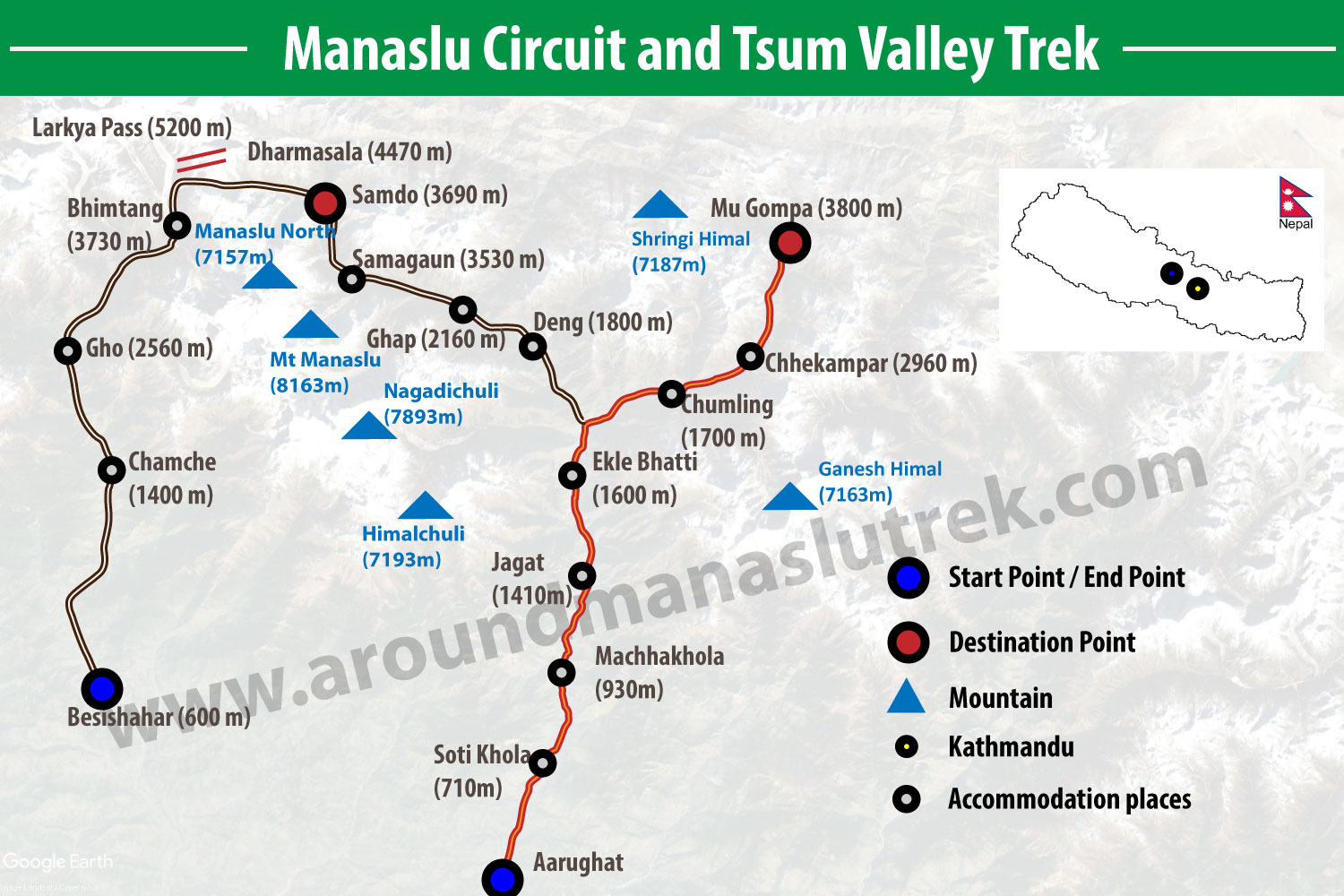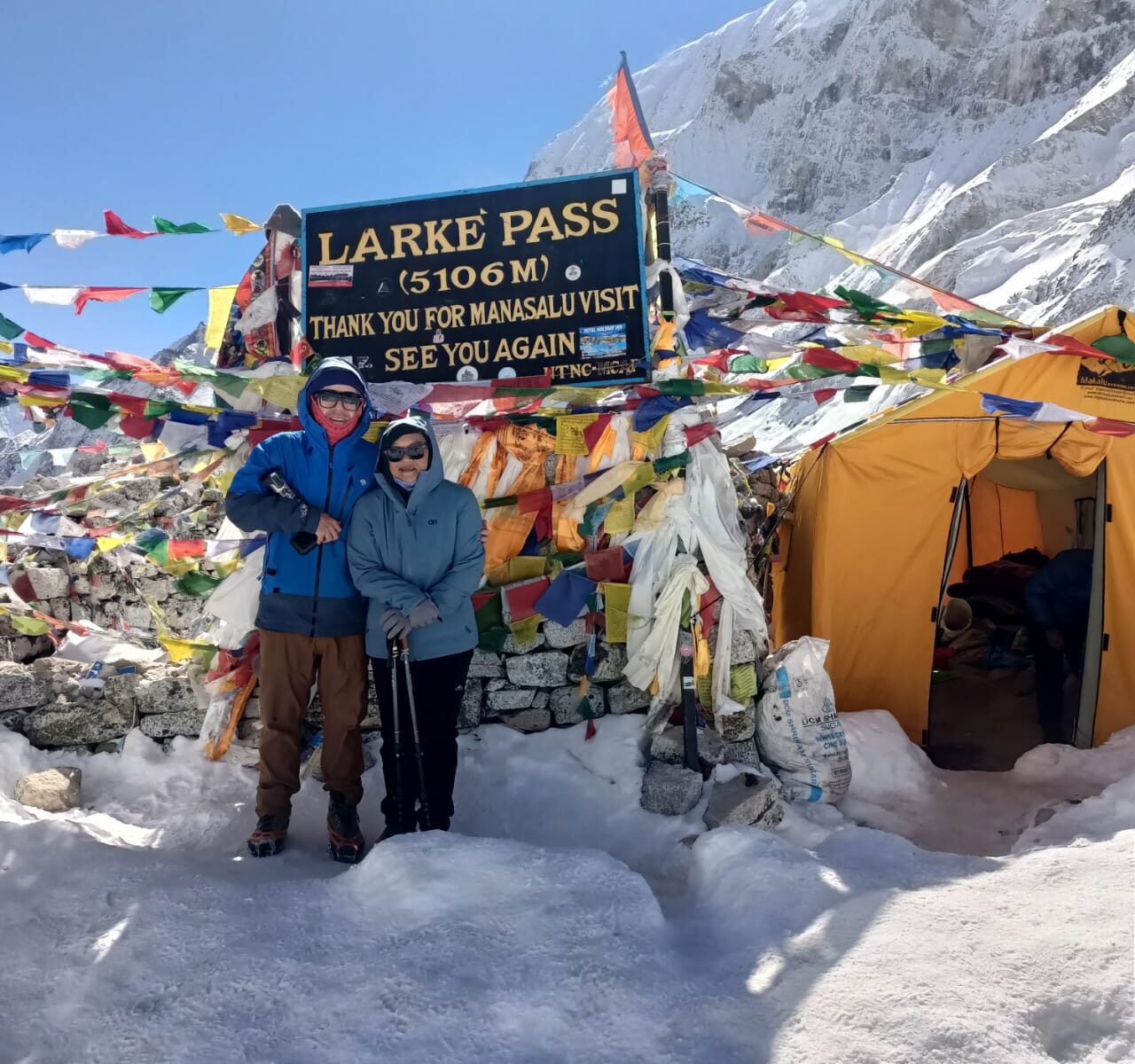The Tsum Valley and Manaslu Trek, which traverses the thrilling Larkya-La Pass, is one of Nepal’s most captivating adventures. This trek takes you through the remote and pristine areas of the Tsum Valley and Manaslu region, both of which were only recently opened to trekkers. In Tsum Valley, you’ll immerse yourself in the practices of Tibetan Buddhism while enjoying breathtaking views of the Ganesh Himal range. Meanwhile, the Manaslu region offers the unique opportunity to circumnavigate the world’s eighth-highest peak, Mt. Manaslu (8,163m). This journey leads you along the serene and secluded trails of the Himalayas, offering an unparalleled trekking experience.
The adventure begins with a scenic drive through the hills to Soti Khola, where the trek officially starts. As you follow the Tsum Valley and Manaslu trekking trail, you’ll traverse numerous ridges and traditional villages, ascending and descending alongside the Budhi Gandaki River. Key attractions in Tsum Valley include Milarepa’s Cave, a sacred site adorned with Buddhist paintings, and the nunneries of Rachen Gompa, Mu Gompa, and Gumba Lungdang, where trekkers are warmly invited to participate in evening pujas. You’ll also visit the Ganesh Himal Base Camp, where panoramic views of the Ganesh Himal range await. The trail then connects to the Manaslu Circuit, leading you through several culturally rich villages with stunning views of the Manaslu range and surrounding Himalayas. A highlight of the trek is crossing the Larkya-La Pass (5,160m), the longest mountain pass in Nepal, after traversing the Larkya Glacier. The journey concludes with a descent along the Marshyangdi River, ending in Jagat, from where you’ll drive back to Kathmandu.
Trek Highlights
- Breathtaking views of Ganesh Himal, Sringi Himal, Boudha Himal, and Himalchuli.
- Exploration of the hidden land where Guru Rinpoche and Milarepa meditated in several sacred caves.
- Widely regarded as Nepal’s finest trek, offering stunning Himalayan scenery, including Mt. Manaslu (8,156m), the world’s eighth-highest peak.
- Crossing the spectacular Larkya La Pass (5,200m).
- A geographically and culturally enriching experience, with the Nupri inhabitants of the upper Budhi Gandaki Valley showcasing a lifestyle, language, and customs deeply rooted in Tibetan culture.
- Encounters with numerous Buddhist Mani walls, ancient monasteries, and picturesque villages with traditional architecture.
- Challenging, off-the-beaten-path routes to Manaslu Base Camp and Ganesh Himal Base Camp.

The trek passes through several ethnic inhabitants along with lush forest and array of mountain peaks. It starts following Budhi Gandaki river and ends in Besisahar, whereas it is the start point of Annapurna Circuit Trek. In an initial, it goes along lush green forest filled with mesmerizing waterfalls and a few suspension bridges. Trekkers need to show their special permits in a check point when they arrive at Jagat as it is the beginning point from where you enter to restricted area. It continues through bamboo, pine and flourished rhododendron forests, bounded by Ganesh Himal, Shringi Himal, Himalchuli and Manaslu. When trekkers approach to Chokhangparo from Chumling, the trek suddenly changes its landscapes and begins with an unreleased communities of Tibetan origin amidst the stunning mountain. During the trail, trekkers will enjoy full of ancient Buddhist monasteries and maniwalls, and then they will back to landscape again when they approach the high elevation.

After you reach to Samagaon, you get a great opportunity of side trips as it is an acclimatization day; either you can go to Manaslu Base Camp or Pungen Gompa which is a less challenging hiking. Furthermore, you can hike to Tibetan border when you stay a night at Samdo. Tibetan border is so close from here, which is one of the main reason behind making of Manaslu a restricted area. You spend your last night at Dharmashala before achieving one of the highlight journey of the trek i.e crossing of Larkya Pass which is at 5160 m above the sea level. After crossing the pass, you will take downhill journey to Bhimtang, Tilije, Tal, and Syanje one after another with having the best accommodation. Finally, we will arrive at Besishahar and end the trek.
Detailed Itinerary
Day 01: Kathmandu to Soti Khola
Drive from Kathmandu to Soti Khola via Aarughat. The journey, which takes approximately 8-9 hours, covers about 130 kilometers. You’ll travel through scenic landscapes and local villages, arriving at Soti Khola at an altitude of 710 meters. Accommodation will be in a local guesthouse.
Day 02: Soti Khola to Machha Khola
Begin your trek from Soti Khola to Machha Khola, a distance of around 14 kilometers. The trek takes about 6 hours and ascends to an altitude of 930 meters. You’ll stay overnight in a local guesthouse in Machha Khola.
Day 03: Machha Khola to Jagat
Trek to Jagat, which is approximately 22 kilometers away and takes about 6 hours. The altitude at Jagat is 1,340 meters. Accommodation will be provided in a local guesthouse.
Day 04: Jagat to Eklebhatti
Today’s trek is about 15 kilometers and will take approximately 4 hours to complete. Eklebhatti is situated at 1,600 meters. You’ll spend the night in a local guesthouse.
Day 05: Eklebhatti to Chumling
The trek from Eklebhatti to Chumling covers around 16 kilometers and takes about 6 hours. Chumling is at an altitude of 2,700 meters. Accommodation will be in a local guesthouse.
Day 06: Chumling to Chhekampar
Travel to Chhekampar, which is approximately 10 kilometers away and takes about 5 hours. The altitude at Chhekampar is 2,960 meters. Overnight accommodation will be in a local guesthouse.
Day 07: Chhekampar to Mu Gompa
This trek covers 16 kilometers and takes about 5 hours. Mu Gompa, located at 3,800 meters, will be your base for the night.
Day 08: Mu Gompa to Chhekampar
Return trek from Mu Gompa to Chhekampar, covering the same distance of 16 kilometers and taking about 5 hours. Accommodation will again be in a local guesthouse in Chhekampar.
Day 09: Chhekampar to Lukpa
Trek from Chhekampar to Lukpa, which is approximately 14 kilometers away and takes around 6 hours. The altitude at Lukpa is 2,240 meters. You’ll stay in a local guesthouse.
Day 10: Lukpa to Deng
Cover a distance of about 12 kilometers from Lukpa to Deng, which takes roughly 5 hours. Deng is situated at 1,800 meters, and accommodation will be in a local guesthouse.
Day 11: Deng to Ghap
Trek to Ghap, located 11 kilometers away, which takes about 5 hours. The altitude at Ghap is 2,160 meters. Spend the night in a local guesthouse.
Day 12: Ghap to Lho Gaun
Travel to Lho Gaun, which is 16 kilometers away and takes approximately 6 hours. Lho Gaun is at an altitude of 3,180 meters. Accommodation will be in a local guesthouse.
Day 13: Lho Gaun to Samagaun
The trek covers 13 kilometers and takes about 3 hours. Samagaun, at 3,530 meters, will be your accommodation for the night in a local guesthouse.
Day 14: Acclimatization Day in Samagaun
Spend a day acclimatizing in Samagaun. You can visit Manaslu Base Camp or Pungyan Gompa, helping your body adjust to the altitude.
Day 15: Samagaun to Samdo
Trek from Samagaun to Samdo, covering about 8 kilometers in 4 hours. Samdo is at an altitude of 3,690 meters. Stay overnight in a local guesthouse.
Day 16: Acclimatization Day in Samdo
Another acclimatization day in Samdo. You can take a short hike to the Tibetan border, which helps in adjusting to the higher altitude.
Day 17: Samdo to Dharmasala
Trek to Dharmasala, which is approximately 7 kilometers away and takes about 4 hours. Dharmasala is at an altitude of 4,470 meters. Accommodation will be in a local guesthouse.
Day 18: Dharmasala to Bhimtang
The trek from Dharmasala to Bhimtang is about 18 kilometers and takes approximately 8 hours, passing over the Larkya La Pass at 5,200 meters. Bhimtang is situated at 3,720 meters, and you’ll stay in a local guesthouse.
Day 19: Bhimtang to Dharapani
Travel from Bhimtang to Dharapani, covering around 16 kilometers and taking about 5 hours. Dharapani is at 2,560 meters. Accommodation will be in a local guesthouse.
Day 20: Dharapani to Kathmandu via Besisahar
Drive from Dharapani to Kathmandu via Besisahar, a distance of approximately 190 kilometers, taking about 8-9 hours. This concludes your trek with an overnight stay in Kathmandu.
Price Includes
- 3 times (Full board) meal per day during the trek
- Seasonal Fruits
- Tea house accommodation during the trek (twin shared accommodation)
- All land transportation as per itinerary (Kathmandu to Soti Khola and Dharapani to Kathmandu by local bus)
- A professional government licensed trekking guide
- All required permits (Restricted area permit, TIMS, Manaslu Conservation Area Permit, and Annapurna Conservation Area Permit)
- Travel and rescue arrangements only
- Duffel bag to carry your equipment and trekking map
- All necessary paper works
- Farewell dinner
- Basic medical kit
- All government and local taxes
Add-ons
- A porter (A porter can carry up to 15 – 20 kg – 1 porter for 2 trekkers)
- Private jeep (Kathmandu to Soti Khola drive)
- All airport-hotel transfers
- Boutique hotel accommodation in Kathmandu with breakfast included (Optional:4-star hotel)
Price doesn’t Include
- International airfares
- Lunch and Dinner in Kathmandu
- Tips for guide and porter
- All additional costs (such as beverages, shopping, etc)
- Travel and rescue insurance
- All the things not mentioned in the inclusion
Route Map of Manaslu Circuit and Tsum Valley Trek

The above map shows a collective information about Manaslu circuit with tsum valley trek. As shown in above map, this trek starts from Aarughat, then passes through several gigantic mountains and poetic Buddhist ethnicity. It crosses one of the highest pass of the Himalaya, called as Larkya Pass and finally ends reaching at Besishahar.
Note: There is not possible to include all attractions and places in a single map. So this map is only a tiny sight of this trek.
Best Time for the Manaslu Tsum Valley Trek
The optimal time for the Manaslu and Tsum Valley Trek is during the Spring and Autumn seasons. These periods offer the most stable and comfortable weather, making them ideal for trekking and mountain climbing. The climate is generally favorable, with mild temperatures and clear skies, allowing for uninterrupted views of the stunning landscapes. Additionally, these seasons experience minimal precipitation, ensuring drier and safer trails, which enhances the overall trekking experience.
Tsum Valley and Manaslu Trek in Autumn
Autumn is an ideal time for the Manaslu Tsum Valley Trek, offering clear blue skies and minimal precipitation as the season follows the monsoon. With moderate daytime temperatures and cooler nights, trekking is comfortable and enjoyable. The stable weather allows for uninterrupted trekking without concerns about rain, making it perfect for exploring the stunning landscapes. Additionally, autumn is rich in cultural experiences, with many local festivals creating a vibrant and festive atmosphere throughout the region. This season offers not only excellent trekking conditions but also a deep cultural immersion.
Tsum Valley and Manaslu Trek in Spring
Spring is another wonderful time for the Manaslu and Tsum Valley Trek. The weather is pleasant, with bright sunny days and a serene environment. Trekkers can enjoy the breathtaking Himalayan scenery without the challenges of heavy rainfall, snowfall, or slippery trails. The trails are free from risks like landslides and avalanches, ensuring a safer trekking experience. Spring also brings a burst of natural beauty, with flowers in full bloom along the trails, enhancing the trek’s appeal. The vibrant colors and blooming flora make for a stunning natural exploration.
Off-Season Tsum Valley and Manaslu Trek
Trekking the Manaslu Tsum Valley in the off-season is possible, but it comes with significant challenges. Off-season conditions include extreme cold, freezing temperatures, heavy snowfall, and the risk of avalanches and landslides. The trails can be infested with leeches during the rainy season, and the weather can be unpredictable, with heavy rain and overcast skies. Given these difficulties, it is recommended to trek during the peak seasons whenever possible. However, for those who seek an extra challenge, off-season trekking requires advanced preparation and training to safely navigate the harsh conditions.
Manaslu Tsum Valley Trek Difficulty
The Manaslu Tsum Valley Trek is considered a moderately difficult trek, often regarded as one of the more challenging routes in Nepal. This trek leads you to remote villages in the Himalayan region near the Tibetan border, navigating through high passes and steep, rugged terrain. The trail’s demanding nature requires both novice and experienced trekkers to be well-prepared. It is highly recommended to undertake this journey with the guidance of experienced trekking guides to ensure safety and a successful trek.
Altitude Sickness in Manaslu Tsum Valley Trek
Altitude sickness is a significant concern on the Manaslu Tsum Valley Trek, particularly as you ascend to the Larkya La Pass at 5,165 meters, the highest point of the trek. This area is often cold and snowbound, increasing the risk of altitude-related issues. Proper acclimatization is crucial to avoid altitude sickness. It is essential to schedule acclimatization days in your itinerary and to listen to your body. If you experience any symptoms of altitude sickness, such as headaches, dizziness, or nausea, it is vital to inform your guide immediately and take appropriate measures. Ignoring these symptoms can be life-threatening, so always prioritize acclimatization and safety.
Trekking Permit
It is the most essential to obtain 3 permits to trek Manaslu and Tsum Valley. MCAP, ACAP and Special restricted area permit are obligatory. For more detail about trekking permit and fees, click here.
Training and Preparation
Remember, you will be crossing 5200 m high Larkya Pass. That is why, you need to be fit and healthy. If you are not physically and mentally prepared for this trip, it is not guarranted that you can successfully complete this trek.
If you have any queries regarding this trip, feel free to leave a comment below. We will reply you within 24 hours.
FAQs
What is Special About the Manaslu Tsum Valley Trek?
The Manaslu Tsum Valley Trek offers a unique opportunity to break away from daily routines and fully immerse yourself in the natural beauty surrounding the 8th highest peak in the world, Mt. Manaslu. This trek also provides a deep cultural exploration of the hidden Tsum Valley, which has captivated visitors with its diverse landscapes and rich Tibetan-influenced traditions. Despite being relatively new to the trekking world, Tsum Valley has quickly gained recognition for its stunning topography and vibrant cultural heritage.
What is the Minimum Budget for the Manaslu Tsum Valley Trek?
The Manaslu Tsum Valley Trek is more expensive compared to other treks in Nepal due to its length and the requirement for two special permits. The budget typically ranges from USD 1,500 to USD 3,500, depending on the level of services and accommodations you choose. This range accounts for the various options available to suit different preferences and needs.
How Difficult is the Manaslu Tsum Valley Trek?
The Manaslu Tsum Valley Trek is considered physically demanding due to its high-altitude trails and rugged terrain. Trekkers should be prepared to walk 6-7 hours each day. Adequate physical fitness and preparation are essential to tackle the challenges of this trek, including the steep ascents and descents.
Is it Safe to Trek the Manaslu Tsum Valley After the Earthquake?
Yes, it is safe to trek the Manaslu Tsum Valley. The trails have been fully repaired and are now safe for trekkers following the earthquake recovery and reconstruction efforts. While some locals are still rebuilding their lives, the trekking routes are well-maintained and secure.
What is the Best Time for the Manaslu Tsum Valley Trek?
The Manaslu Tsum Valley Trek is best undertaken in the spring and autumn. These seasons offer clear weather and stunning scenery, with autumn providing vibrant festival experiences and spring showcasing blooming rhododendrons. Winter is not recommended due to extreme cold and potential snowfall, which can lead to trail blockades.
Are There Hospitals or Medical Facilities During the Manaslu Tsum Valley Trek?
Basic medical facilities are available at several health posts along the trek. However, it is advisable to carry your own regular medications. For more serious conditions, medical evacuation may be necessary.
What Happens in Case of an Emergency During the Trek?
In the event of an emergency, experienced and knowledgeable trekking staff and guides will assist you. They are familiar with the local terrain and risks and will coordinate with your trekking agency to provide the best possible support and guidance.
What Foods and Accommodations Can We Expect During the Trek?
During the trek, you will stay in tea houses, lodges, and tent camps. Meals typically include traditional Nepali dishes like Dal-Bhat, along with other local fare. Accommodations are basic but comfortable, providing a traditional trekking experience.
Why Choose Nepal Mountain Trekkers for the Manaslu Tsum Valley Trek?
Nepal Mountain Trekkers is renowned for its experienced team, which has over two decades of expertise in Himalayan trekking. Their knowledgeable staff and high client satisfaction rates reflect their commitment to providing exceptional trekking experiences. Choosing this agency ensures a well-organized trek and memorable journey.
Why Do We Need a Guide and Porter for the Trek?
A licensed guide is essential for navigating the trek and providing insights into the local culture and geography. A porter can enhance your comfort by carrying your gear, allowing you to focus on enjoying the trek. Both guide and porter contribute significantly to the overall trekking experience.
Is the Water Safe to Drink?
The water along the trek is sourced from rural facilities such as taps, wells, and hand pumps. It is crucial to purify this water before drinking, either by using bottled water, purification tablets, or other water treatment methods to ensure safety.
